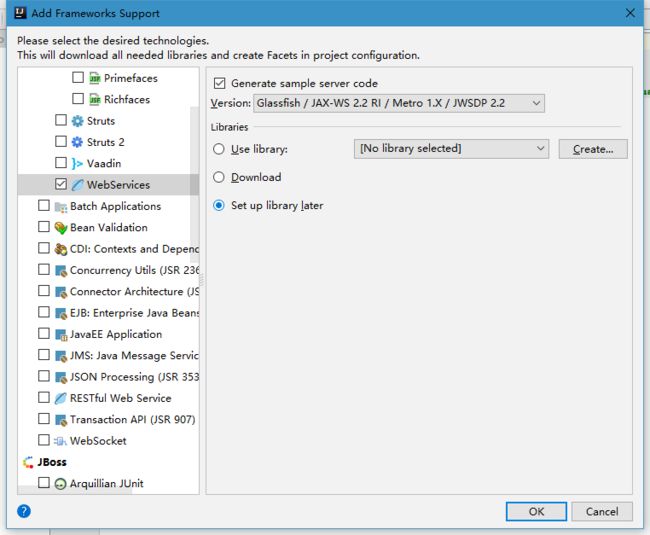IDEA+Maven+Embedded Jetty+Jersey构建Restful服务并打包成jar包发布
一、简要介绍
最近做的项目用到了嵌入式Jetty当服务器,并用Jersey来构建Restful api,看了老师的项目文件发现还有pom.xml文件,才知道Maven。但因为不是一个组的老师,而且那个老师貌似前端精通的多一点,Maven什么的也不是很了解,从老师那里学的东西也不是很多。因为项目相关,最后还是自己Google各种资料,一点一滴从零开始学习。国内关于嵌入式Jetty的资料真的少,大部分都是翻译官方文档,很难找到完整的案例。因此,想在这里把自己学到的关于Embedded Jetty、Jersy的知识记录下来,希望提能给想入坑的提供点经验,少走点弯路。
二、环境需求
文中介绍的东西都是基于JDK1.8、Maven3、IDEA2017.2,Jetty版本为9.4.3.v20170317,Jersey版本为2.25.1。
三、具体步骤
1、新建maven空项目
打开IDEA,新建一个Project,选择Maven项目,然后填写一些基本信息,最后新建的项目如下图所示

可以看到新建的项目除了/src/main/java代码包和/src/main/resources资源包之外,还多了一个pom.xml的文件,Maven项目中对项目的管理配置都在pom.xml文件中进行,主要包括添加jar包依赖,对项目进行清理打包构建等等。
2、添加辅助框架
右键项目名称,然后点击Add Framework Support。

左侧选中WebService,右侧选中Set up library later,然后点击OK。

添加完成后,会在项目的结构树中看到多出/web目录,并在/src/main/java包中多出一个example,红色的/target目录是编译文件夹,编译后的class文件都在里面。

3、添加jar包依赖
我们将example包整个删除,然后打开pom.xml,添加Rest项目需要的jar包依赖,在Maven项目中,当你需要引入jar包时,只需要在pom.xml文件中填上所需jar包的Maven坐标即可,Maven坐标由三部分组成,分别是groupId,artifactId,version,形式如下:
<groupId>org.glassfish.jersey.coregroupId>
<artifactId>jersey-serverartifactId>
<version>2.25.1version>当在Maven项目中引入jar包依赖时,只需要按照如下形式,把坐标放在一个
本项目中所用到的所有依赖关系如下所示:
<dependencies>
<dependency>
<groupId>org.glassfish.jersey.coregroupId>
<artifactId>jersey-serverartifactId>
<version>2.25.1version>
dependency>
<dependency>
<groupId>org.glassfish.jersey.containersgroupId>
<artifactId>jersey-container-servlet-coreartifactId>
<version>2.25.1version>
dependency>
<dependency>
<groupId>org.glassfish.jersey.containersgroupId>
<artifactId>jersey-container-jetty-httpartifactId>
<version>2.25.1version>
<exclusions>
<exclusion>
<groupId>org.eclipse.jettygroupId>
<artifactId>jetty-utilartifactId>
exclusion>
exclusions>
dependency>
<dependency>
<groupId>org.glassfish.jersey.mediagroupId>
<artifactId>jersey-media-moxyartifactId>
<version>2.25.1version>
dependency>
<dependency>
<groupId>org.eclipse.jettygroupId>
<artifactId>jetty-serverartifactId>
<version>9.4.3.v20170317version>
dependency>
<dependency>
<groupId>org.eclipse.jettygroupId>
<artifactId>jetty-servletartifactId>
<version>9.4.3.v20170317version>
dependency>
<dependency>
<groupId>org.eclipse.jettygroupId>
<artifactId>jetty-webappartifactId>
<version>9.4.3.v20170317version>
dependency>
<dependency>
<groupId>org.glassfish.jersey.mediagroupId>
<artifactId>jersey-media-multipartartifactId>
<version>2.25.1version>
dependency>
<dependency>
<groupId>javaxgroupId>
<artifactId>javaee-web-apiartifactId>
<version>7.0version>
dependency>
dependencies>4、搭建Embedded Jetty服务器
在/src/main/java中新建包com.heu.cs.jettyserver,在包中新建类JettyServer,写入代码
package com.heu.cs.jettyserver;
import org.eclipse.jetty.server.*;
import org.eclipse.jetty.server.handler.HandlerCollection;
import org.eclipse.jetty.servlet.DefaultServlet;
import org.eclipse.jetty.servlet.ServletContextHandler;
import org.eclipse.jetty.servlet.ServletHolder;
public class JettyServer {
public static void main(String[] args) throws Exception {
Server jettyServer = new Server();
HttpConfiguration http_config = new HttpConfiguration();
/**
*http_config可以对服务器进行配置,比如设置https,BufferSize等等
* http_config.setSecureScheme("https");
* http_config.setSecurePort(8443);
* http_config.setOutputBufferSize(32768);
* http_config.setRequestHeaderSize(8192);
* http_config.setResponseHeaderSize(8192);
*/
http_config.setSendServerVersion(true);
http_config.setSendDateHeader(false);
/**
* 新建http连接来设置访问端口,超时时间等等。
*/
ServerConnector httpServer = new ServerConnector(jettyServer,
new HttpConnectionFactory(http_config));
httpServer.setPort(7012);
httpServer.setIdleTimeout(120000);
jettyServer.addConnector(httpServer);
/**
* 设置整个web服务的根url,/ 表示 localhost:7012/ 之后地址的是可访问的
*/
ServletContextHandler context = new ServletContextHandler(ServletContextHandler.SESSIONS);
context.setContextPath("/");
/**
* 添加动态servlet路径,处理我们自己写的动态的servlet
*/
ServletHolder jerseyServlet = context.addServlet(
org.glassfish.jersey.servlet.ServletContainer.class, "/webapi/*");
jerseyServlet.setInitOrder(1);
// Tells the Jersey Servlet which REST api/class to load.设置动态servlt加载的包
jerseyServlet.setInitParameter("jersey.config.server.provider.packages", "com.heu.cs.api");
//也可单独设置加载某个类,
jerseyServlet.setInitParameter("jersey.config.server.provider.classnames",
"UploadFileService;org.glassfish.jersey.media.multipart.MultiPartFeature");
/**
* 添加默认的servlet路径,处理不在动态servlet路径中的地址,一般都是一些可供访问的静态html,css,js资源文件
*/
ServletHolder staticServlet = context.addServlet(DefaultServlet.class, "/static/*");
staticServlet.setInitParameter("resourceBase", "src/main/resources");
staticServlet.setInitParameter("pathInfoOnly", "true");
/**
* Embedded Jetty还可以直接当作服务器,在上面部署已经发布的war包,这方面的资料国内挺多的,就不累述
*
* 其次,在我们的项目中是没有用到web.xml文件来进行webappde的配置,因为上面的设置并不能使得服务器访问web.xml,
* 如果需要用到web.xml,则需要new一个WebAppContext,并对其进行配置,同时在下面的handlers中加上webAppContext
* WebAppContext webAppContext = new WebAppContext();
* 设置描述符位置
* webAppContext.setDescriptor("./web/WEB-INF/web.xml");
* 设置Web内容上下文路径
* webAppContext.setResourceBase("./web");
* 设置上下文路径
* webAppContext.setContextPath("/");
* webAppContext.setParentLoaderPriority(true);
*/
HandlerCollection handlers = new HandlerCollection();
// handlers.setHandlers(new Handler[]{context,webAppContext});
handlers.setHandlers(new Handler[]{context});
jettyServer.setHandler(handlers);
try {
jettyServer.start();
jettyServer.join();
} finally {
jettyServer.destroy();
}
}
}5、访问静态资源
至此,一个简单的Embedded Jetty服务器已经搭建完成,当我们需要启动服务器时,只需秩序JettyServer中的main方法即可。
项目中静态资源的访问根URL是http://localhost:7012/static/,我们在/src/main/resources目录下新建一些js、css、html文件,然后启动服务器

然后在浏览器中输入http://localhost:7012/static/即可访问到这些文件
6、访问动态Api
我们在前面实现了访问静态资源,如果说想实现访问动态资源,譬如我想访问动态URL路径下的某个Apihttp://localhost:7012/webapi/demo,该如何实现呢?
在JettyServer中我们已经设置了动态资源的访问根URLhttp://localhost:7012/webapi,并设置了访问动态资源时加载的包为com.heu.cs.api,也就是说,当我们访问动态资源时,服务器会向这个包里寻找我们要访问的路径及其响应。
下面我们在这个包里新建一个类名为Demo,其中代码如下
package com.heu.cs.api;
import javax.servlet.http.HttpServletRequest;
import javax.ws.rs.GET;
import javax.ws.rs.Path;
import javax.ws.rs.Produces;
import javax.ws.rs.core.Context;
import javax.ws.rs.core.UriInfo;
/**
* Created by memgq on 2017/8/5.
*/
@Path("demo")
public class Demo {
@Context
UriInfo uriInfo;
@Context
HttpServletRequest request;
@GET
@Produces("text/plain;charset=utf-8")
public String index() {
return "这是通过动态servlet生成的内容";
}
@GET
@Path("secondlevel")
@Produces("text/plain;charset=utf-8")
public String second() {
return "rest多级路由";
}
}在Demo这个类中,我们使用到了Jersey**注解开发**,其中@Path代表访问路径,class上为一级路径,里面可以设置二级路径,@GET、@POST为访问方法,@Produces表示响应响应回去的类型,关于Jersey常用的注解开发及注解类型,网上资料多尔全面,这里也不累述。
在Demo中,我们添加了一个一级URL/demo和一个二级URL/demo/secounlevel,在前面加上根URLhttp://localhost:7012/webapi,我们即可访问到自己用生成的动态资源
四、Embedded Jetty项目打包
当我们完成webapp开发后,想要将这个项目发布出去,该怎么办?在这里Maven给我们提供了打包插件maven-shade-plugin,通过在pom.xml文件中对项目进行配置,即可完成打包工作,将项目打包成可执行的jar包发布出去。pom.xml中的配置如下
<build>
<finalName>RestDemofinalName>
<plugins>
<plugin>
<groupId>org.apache.maven.pluginsgroupId>
<artifactId>maven-shade-pluginartifactId>
<version>3.0.0version>
<configuration>
<createDependencyReducedPom>truecreateDependencyReducedPom>
<filters>
<filter>
<artifact>*:*artifact>
<excludes>
<exclude>META-INF/*.SFexclude>
<exclude>META-INF/*.DSAexclude>
<exclude>META-INF/*.RSAexclude>
excludes>
filter>
filters>
configuration>
<executions>
<execution>
<phase>packagephase>
<goals>
<goal>shadegoal>
goals>
<configuration>
<transformers>
<transformer
implementation="org.apache.maven.plugins.shade.resource.ServicesResourceTransformer" />
<transformer
implementation="org.apache.maven.plugins.shade.resource.ManifestResourceTransformer">
<manifestEntries>
<Main-Class>com.heu.cs.jettyserver.JettyServerMain-Class>
manifestEntries>
transformer>
transformers>
configuration>
execution>
executions>
plugin>
<plugin>
<groupId>org.apache.maven.pluginsgroupId>
<artifactId>maven-compiler-pluginartifactId>
<configuration>
<source>1.7source>
<target>1.7target>
configuration>
plugin>
plugins>
build>
打包时,鼠标放在IDEA左下角的正方形图标,然后点击Maven Projects

关闭JettyServer.main,然后依次点击Maven中的clean->install,最后打包完成的jar包会放在/target目录下

然后打开CMD,进入次目录下,键入java -jar RestDemo.jar即可执行程序。

* 注意事项
* 通过这种方法打包的jar包并不包括Resources中的静态资源文件,静态资源文件需要提取出来放到与jar包相同的目录中,打包后仅包含/src/main/java中的编译文件。因此在复制静态资源文件时需要按照/src/main/resources这样的路径拷贝过来。
五、总结
我用这个嵌入式Jetty当服务器开发有半年左右,因为基础差,学到的东西不是很多,前期什么都不懂,好多简单的东西都要琢磨很久,走了很多弯路,尤其是打包那一块,对Maven也不熟悉,所以折腾了很久,才找到这个简陋的方法。希望记录下来自己用到的东西,能够帮助到其他人。



